Pelargonium zonal: home care
Pelargonium, or geranium, is one of the most popular home flowers. He conquered flower growers with his unpretentiousness and long flowering period. This plant has many varieties. In the article, we will talk about zonal pelargonium, which is called in the common people "kalachik".
















Botanical description of the plant
Zonal pelargonium is a perennial lush shrub with many years, with a direct stem dotted with green leaves. Each leaf has concentric circles of brown or saturated green. From here the names “zonal”, “kalachik” came out. The surface of the leaves is fleecy, which is why they feel like velvet to the touch.

| Root system | Ramified |
| Stem | Straight |
| Leaf shape | Rounded, slightly lobed, with denticles |
| Leaf color | Green, with concentric circles dark green or brown |
| Flower shape | Umbrella inflorescences with simple or slightly double flowers |
| Flower color | Various |
| Fruit shape | Box |
| Fruit color | Green; ripened acquires a brownish yellow color |
Varieties
The existing varieties of Kalachik varieties of botany are grouped based on such characteristics:
- stem length;
- number of petals;
- the shape and color of the petals;
- shape and color of leaves.
Did you know? Zonal pelargonium came to Europe from the Cape Colony, the Kinsterbosch Botanical Garden (a small floristic kingdom, which is part of South Africa) in 1710. Initially, the flower had a long stem, but during the selection, scientists were able to get a compact plant, known to us today. It was in the 50s of the XIX century.
Each of these groups has several subgroups. The most popular representatives are:
- Chandelier Violet. It grows to a height of 35 cm. It has a rounded foliage with a dark horseshoe-shaped spot. It blooms in purple. Drought-resistant, grows well both in pots and in open ground. Loves the sun.

- Multibloom. Flower height 25-30 cm, compact, with green foliage with a chocolate hue. It grows well in small pots (d = 10.5 cm), can be grown in containers. It has several subspecies that differ in the color of the flowers.
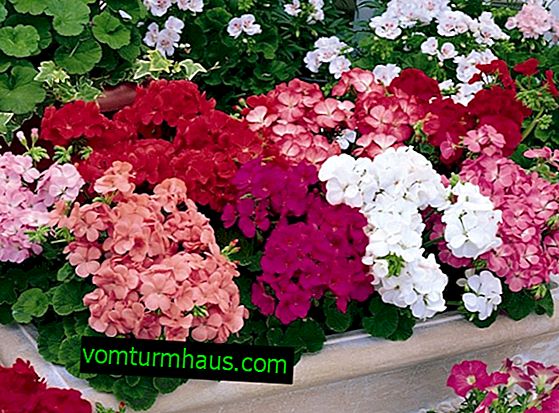
- Colorama. The flower is a dense erect bush with a height of 35-50 cm. The foliage is dark green, with a dark ring. Flowers are collected in fairly large spherical inflorescences of red, pink, white, salmon shades. They grow well both at home and in the open ground, where they bloom right up to frosts.
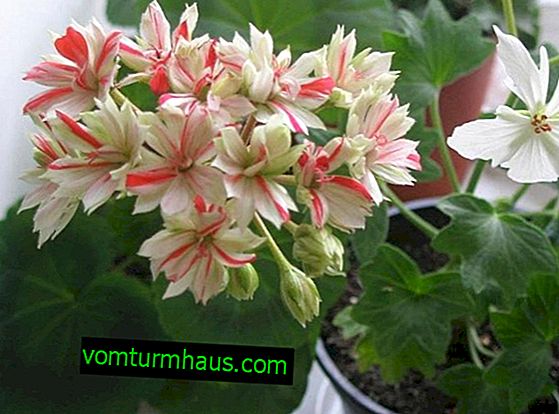
House growing conditions
Pelargonium is a lover of heat, light and moderate humidity. Choosing a place with suitable conditions, you can enjoy the riot of greenery and lush flowering.
Place for a flower
Kalachik is a photophilous plant. With a lack of lighting, its foliage becomes faded, the bush itself is stretched, and flowering becomes not so plentiful. Therefore, it must be placed on the south side. So that direct sunlight does not burn the leaves, geraniums must be shaded. In winter, additional lighting should be arranged.
Temperature mode
During the active phase of growth and flowering, temperature + 20- + 25 ° С will be comfortable for geraniums. Starting in October (and until February itself), growth slows down, so the flower needs coolness. The plant will be comfortable at + 12- + 15 ° С. Since it is difficult to maintain such a temperature regime at home in winter, you need to follow this rule: the more significant the temperature differs from the comfortable one, the more light should be received by the fist.
Important! Kalachik does not like moisture to stagnate in a pot and onto leaves. This provokes the development of rot. Therefore, it is desirable to water under the root or through a tray.
Air humidity
Pelargonium does not like moist air, so humidity should be kept moderate. In addition, it is not necessary to humidify the air by spraying. The main thing is to ensure that it does not dry out. To do this, regularly air the room.
Home Care
Pelargonium came to us from the arid African continent, so it is unpretentious in leaving and does not require special skills.

Watering
Despite the fact that pelargonium is a drought tolerant plant, it must be watered regularly. This will save a riot of flower colors. In the hot season, irrigation is carried out every 3-4 days, when the top layer of the earth in the pot becomes dry. In winter, the soil should dry to 1/3 of the depth. It is advisable to use water that is standing or melt, rain (room temperature).
Top dressing
Geranium is fed in the period of active growth - from March to September. In winter, when the flower is resting, it is not necessary to feed. The frequency of fertilizer is once every 14 days. It is advisable to use phosphate fertilizers.
Important! You can not transplant blooming geraniums. If you have flooded the flower, or the roots are bare, then add a little fresh earth and wait until the flowering period ends.
Pruning
So that the bush does not stretch and has a beautiful compact shape, as well as blooms more abundantly, it must be cut periodically. Carry out the procedure after winter. Live shoots are pruned so that 2-5 buds remain. Dead and sick are removed completely. Dry and yellowed foliage is also trimmed. It needs to be trimmed, not torn, so that the plant is minimally injured. After flowering, dried umbrellas are removed.

Transfer
Pelargonium does not like transplantation, therefore it is necessary to carry out it once or twice a year and only when you find that:
- the roots filled the entire pot;
- the flower began to die due to waterlogging;
- the earth in the pot sagged strongly and exposed the roots.
Having picked up the pot, we begin the transplant:
Recommended Reading

- Disinfect the selected container if another flower has previously grown in it.
- At the bottom, put drainage from small stones or crushed polystyrene.
- Moisturize the plant well and turn the pot over, remove the flower from it by tapping it slightly on the sides of the pot.
- Inspect the roots for diseases and pests. Remove affected ones.
- Place the geranium in a new pot and sprinkle with a mixture of two parts of leafy soil, two parts of humus and sod land, one part of sand. You can choose another mixture: peat, humus, compost soil, sand, taken in equal proportions.
- Water the flower a little and place it in a dark place for 7 days. After transfer to the light. After two months, feed your little fist.
Breeding
Pelargonium is propagated by seeds and cuttings. Further on each of the methods of reproduction in detail.
Cuttings
Cuttings are harvested in February-March (or in July-August). Cut the stalk 5-7 cm long, with 2-3 leaves. Leave it to tighten a little, and then root it in one of the ways:
- in water;
- in a peat tablet;
- in a mixture of peat and coarse granular sand.

Did you know? Essential oils are extracted from geranium, which are widely used in the perfumery and confectionery industries.
Seed cultivation
Purchased seeds are sown for germination in January-March. The step-by-step process looks like this:
- Shallow capacity is selected, washed thoroughly. Make drainage holes in it.
- The tank is filled with soil for geraniums, slightly compacted and watered.
- Using a toothpick, the seeds are deepened into the soil by 5 mm at a distance of 50 mm from each other. They can be laid out along the grooves or in the holes. Sprinkle the seeds on top with earth.
- Biohumus is prepared for seedlings (diluted with water in a ratio of 3: 200 ml) and poured into a spray bottle.
- Seedlings are sprayed with a mixture to saturate the soil with beneficial microflora.
- The container with seedlings is covered with a film and carried away in a warm and bright place. The required temperature for the emergence of seedlings is + 18- + 22 ° C. Sprouts are irrigated with a spray gun and regularly ventilated. When the first shoots appear, the temperature is lowered by two degrees.
Pickling seedlings is made with the advent of 3-4 real leaves.
Video: growing pelargonium from seeds
Possible growing problems
All types of geraniums are considered resistant to diseases and pests. But if you do not care for the flower, then it is often attacked by rot and various pests.
Disease
The most common diseases of pelargonium arising from non-compliance with flower care rules are:
- Gray mold or rot. Covers foliage with excessive wetting of the plant. To get rid of it, you need to temporarily stop watering the flower. Cut off all damaged leaves. Treat with antifungal agent.
- Root rot. Attacks the root system. It is impossible to cope with it. The plant dies.
- Powdery Mildew Fungal disease covering the leaves with white coating. It manifests itself in high humidity and low temperature. It is treated with the help of special chemicals.
- Rust. On the outside, the leaf is covered with red spots with an even border, and on the back with black pustules. The causative agent can enter the plant through water or air, but it will manifest itself if the soil is wet, the air humidity will increase. To combat the disease, you need to limit watering, transfer the flower to a dry place and treat with fungicides.
- Verticillin wilt. In the lower part of the bush, the foliage begins to turn yellow and fade. The diseased flower needs to be transplanted into a new pot with new earth, having previously removed all affected leaves. Then treat with “Vitaros” or “Fundazole”.
Find out why geranium leaves turn yellow at home.
Pests
A peculiar pungent smell usually scares away all insects, but sometimes pests can attack the plant:
- Whitefly It settles on the inside of the leaf. Treatment with soapy water and wrapping in a plastic bag for 1.5-2 hours will help to overcome it. If it doesn’t help, then you should treat it with Aktara.
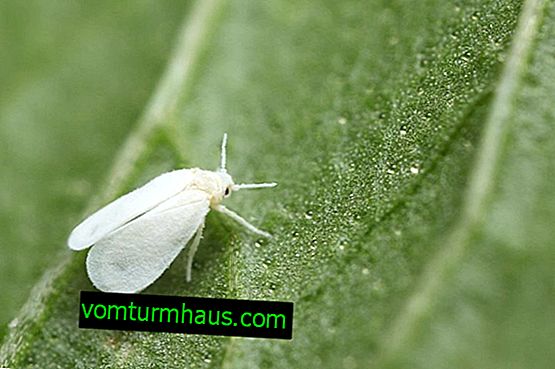
- Aphid. Usually covers the lower foliage. A special insecticide will help to remove it.
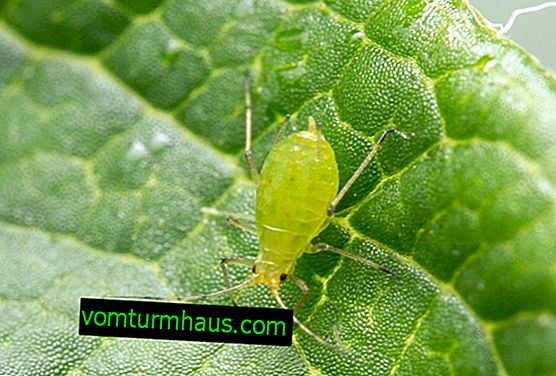
- Spider mite. It settles on the inside of the leaves and covers them with small white dots. The plant must be treated with acaricides according to the instructions on the package.
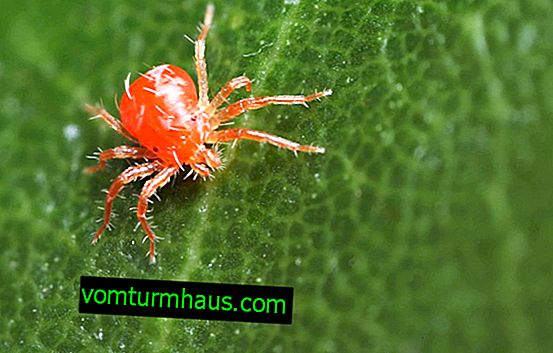
Pelargonium is an unpretentious flower. It is suitable for beginner gardeners. Subject to the rules for his care, he will delight with a riot of colors all year round.









